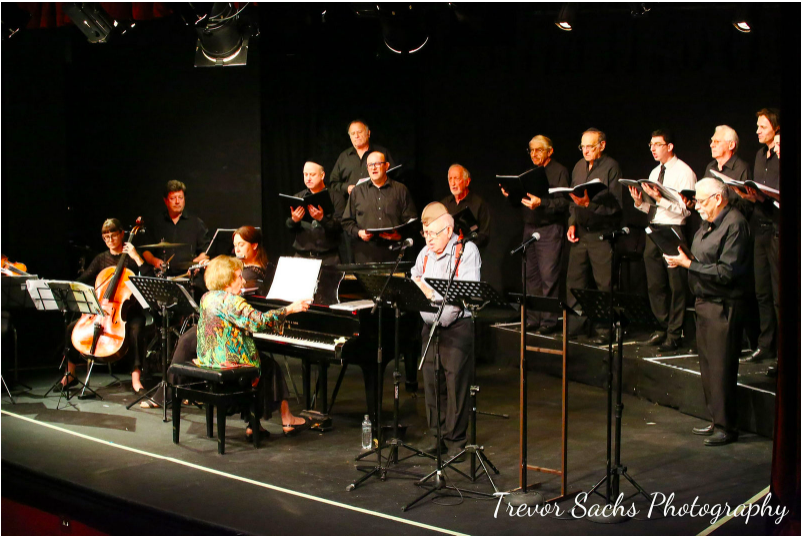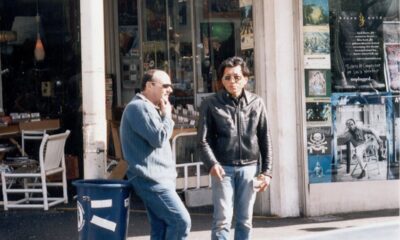
Lifestyle

On cantors and choirs: sifting through the soundtrack of SA Jewry
Published
3 years agoon
By
Mirah LangerHistory books may detail the facts, but it’s through the notes and melodies of Jewish liturgical music that the emotional story of the Jews of South Africa can be heard. Now, two afficionados on the subject have begun the mammoth task of collating the tales of cantors and choirs on the tip of Africa, detailing its rich legacy and hopes for the future.
“Chazzanut [cantorial music] is a unique Jewish creation. The chazzan [cantor] is described as a chacham lev – he who has the wisdom of the heart,” says Evelyn Green, who along with Professor Russel Lurie, has dedicated herself to the preservation and practice of Jewish liturgical music in South Africa. After all, she reflects, “What are the Jewish people without their music?”
Green and Lurie have been stalwarts of the Johannesburg Jewish Male Choir (JJMC), Green since its inception in 1985, and Lurie, an acclaimed maxillofacial and oral surgeon, since 1987. Green, who is also renowned for her work as a Unisa (University of South Africa) music examiner and private music and singing teacher, is the choir’s musical director, secretary, and repetiteur (singing coach). For the past 25 years, Lurie has served as its chairperson. Most recently, they have begun collating and researching the history of the cantorial and Jewish liturgical musical tradition in this country – the first such project of its kind.
Last month, they presented a set of webinars under the auspices of the Cantors’ Assembly in America. They also spoke to the SA Jewish Report about their extensive work together and their determination to take it even further while keeping the art form alive and thriving.
The interweaving of the everchanging South Africa context and this centuries-old Jewish tradition is illustrated by a delightful anecdote involving a cross-over choir, a bottle of whiskey, and a compulsory invitation to the home of the late Chief Rabbi Cyril Harris.
As South Africa commenced its democracy, “within this political scenario, the choir embarked on an outreach programme and on occasions, combined with one of the country’s best black choirs, Imilonji KaNtu Choral Society,” says Green.
However, Imilonji KaNtu is made up of male and female singers, and this doesn’t comply with Jewish Orthodox tradition. Nevertheless, in 2000, in the spirit of the times, the JJMC felt the collaboration had such deep meaning, performing together could be justified.
“A few days before our concert,” says Lurie, “my secretary [of his medical practice] came into the office and said Chief Rabbi Harris was on the phone and wanted to speak to me. In his broad, Scottish accent, he said, ‘Russel, I want you at my home at 18:00, and bring Evelyn as well.’
“We walked in, and the tension was there. We sat down, and he brought out a tray with whiskey. He said, ‘We have a problem: Russel, Evelyn, you are against halacha. You know that men and women cannot sing together, but I want to congratulate the two of you because you have made a stride in the building of a rainbow nation.’”
Then, recalls Lurie, he immediately turned to the next task at hand asking, “Now how do you take your whiskey, because if you want water with it, you’ll have to find some other place.” Then he turned to Evelyn, joking “and you are too young for this, you can have a cooldrink”.
At the end of the evening, he told Lurie and Green, “Anne [Harris’s wife] and I will be at the concert. Leave the rabbinate to me, but don’t ever do it again.”
Green remembers opening night. “It was at the Linder Auditorium, which was totally packed except for two empty seats. We waited for five and then ten minutes before deciding that we had better start, and as I walked onto stage, they arrived.” Harris remained a keen fan of the JJMC for the rest of his life, hosting them for a lunch every year. “He was the most wonderful man and supporter,” reflects Green.
Jewish liturgical music was first carried to South African shores by immigrants fleeing pogroms and unrest in Eastern Europe. The Yiddish songs they carried with them were anthems to love, loss, and resilience.
After World War II, South Africa became a safe haven for refugees who brought both Ashkenazi and Sephardi music traditions. Lurie details how one chazzan of the Oxford Shul in the 1970s was in fact a Holocaust survivor who was taken, along with thousands of others, to the shooting pits. “He lifted his arms and pleaded with the officer in charge to let him sing a prayer for his people. They let him sing, and they pulled him out.”
Indeed, as Europe struggled in disarray in the aftermath of the devastation, South Africa was seen as an attractive option for chazzans to come and work. “South Africa was a springboard. The cantors would come and stay for four or five years and move on,” says Lurie.
Some of the most acclaimed cantors in the world spent time in South Africa. A special story is told across three generations of the Alter family, starting with Israel Alter who was born in the Ukraine, and studied in Vienna and Hanover, before arriving in South Africa in 1936, fleeing Nazi rule. He went on to serve for 25 years at the Great Synagogue in Johannesburg. His son, Elazer Alter, followed in his footsteps at various shuls in Johannesburg and today, Israel’s grandson, Avron, serves as the cantor at Sandton Synagogue.
In the 1980s, visits by icons of liturgical music like Rabbi Shlomo Carlebach and cantor Sol Zim, as well as the influence of cantor Ari Klein, resulted in experimentation in a new direction. Classical chazzanut was blended with Hasidic and even contemporary pop and folk music. Klein “introduced a light-hearted approach to services and his rendition of foot-tapping music had his congregation in awe,” recalls Green.
So popular did this trend of contemporary experimentation become, Harris even joked in his memoir that he had not known that Andrew Lloyd Webber composed music for the synagogue.
From this heyday of excitement and innovative energy, the current status quo is more concerning, say Lurie and Green. While South Africa certainly boasts superb local home-grown talent in the field, there appears little community support for these efforts in terms of sponsorships. Moreover, say Lurie and Green, there isn’t sufficient effort in Jewish education to promote musical appreciation and practice.
Most chazzans are able to practice their art only in a part-time capacity as they must find other employment to make ends meet. In addition, in South Africa, the shtibl shul set-up, whereby there is no chazzan or choir at services, is the increasingly popular choice, particularly of younger generations.
It’s all the more pity, say Green and Lurie, because their own lives are testament to what richness an immersion in the music has brought. “There is no end to it, and it is so beautiful,” says Lurie.
Green recalls the poignancy of experiences like when the choir was invited to the first International Louis Lewandowski Choral Festival in Berlin in December 2011. At one point, the choir was taken to the cemetery of Lewandowski, one of the greatest composers of Jewish music. It was pouring with rain and freezing cold, yet the choir sang in his honour by his grave. When they visited the Holocaust memorial in the city, they too chose song to express themselves.
Lurie says it was an act of the most sacred affirmation. “It showed, ‘Look we are here. Not only are we here – we are singing!’”










